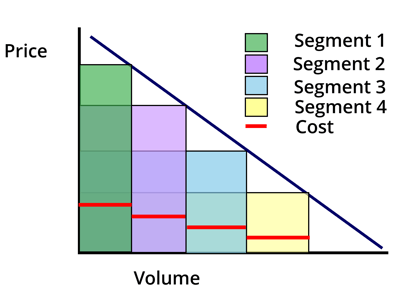Methods for Understanding What Customers are Willing to Pay
 PriceBeam
·
8 minute read
PriceBeam
·
8 minute read

Abstract: Understanding what customers are willing to pay for a product or service is crucial for businesses seeking to maximize profits and market share. This article delves into various methods for conducting market research to gain insights into customer pricing preferences. Topics covered include quantitative and qualitative research approaches, primary and secondary data sources, pricing research techniques, and the importance of segmentation and competitive analysis. By adopting a systematic approach to pricing research, businesses can make informed decisions that benefit both their bottom line and their customers.
1. IntroductionIn today's competitive business environment, pricing decisions are critical to success. Setting the right price for a product or service not only influences consumer perception and purchase decisions but also impacts profitability and market share. To determine the optimal price point, businesses must understand their target audience and ascertain what customers are willing to pay. Market research is the key to unlocking this information.
This article examines various methods for conducting market research to better understand customer pricing preferences. Through a combination of quantitative and qualitative research, primary and secondary data sources, and pricing research techniques, businesses can make informed pricing decisions that cater to their target market and align with their strategic objectives.
2. Quantitative vs. Qualitative Research
When conducting market research, businesses can choose between quantitative and qualitative research methods or use a combination of both.
Quantitative research focuses on obtaining numerical data to identify patterns and trends in customer behavior. It usually involves larger sample sizes and employs statistical analysis to draw generalizable conclusions. Common quantitative research methods include surveys, experiments, and observations.
Qualitative research, on the other hand, seeks to understand the underlying reasons and motivations behind customer behavior. It often involves smaller sample sizes and aims to gather in-depth insights into customer opinions, preferences, and attitudes. Typical qualitative research methods include interviews, focus groups, and case studies.
Selecting the appropriate research method depends on the research objectives, the resources available, and the desired level of detail. A combination of both quantitative and qualitative research methods can provide a comprehensive understanding of customer pricing preferences and inform pricing decisions.
3. Primary vs. Secondary Data Sources
Market research can be conducted using primary or secondary data sources. Primary data is collected directly from the target audience, while secondary data is gathered from existing sources.
Primary data collection methods include surveys, interviews, focus groups, and observations. These methods allow businesses to obtain customized information that is specific to their research objectives. However, primary data collection can be time-consuming and costly.
Secondary data, on the other hand, comes from pre-existing sources such as government reports, industry publications, and competitor data. It is more cost-effective and readily available, but may not be tailored to the specific research objectives.
Using a combination of primary and secondary data sources can provide a more comprehensive understanding of customer pricing preferences and help businesses make informed pricing decisions.
4. Pricing Research Techniques
Several pricing research techniques can be used to understand what customers are willing to pay for a product or service. Some of the most commonly used techniques include:
4.1 Conjoint Analysis
Conjoint analysis is a quantitative research method used to measure customer preferences and willingness-to-pay for various product attributes, including price. This technique involves presenting respondents with a series of hypothetical product or service offerings that differ in their attributes and asking them to rank or rate their preferences.
The objective of conjoint analysis is to estimate the relative importance of each attribute and how changes in these attributes affect customer preferences. By incorporating price as one of the attributes, researchers can assess how customers trade-off between price and other product features, ultimately revealing their willingness-to-pay for various combinations of attributes.
To use conjoint analysis for measuring willingness-to-pay, follow these steps:
- Identify product attributes: Determine the key attributes of the product or service, including price, which are relevant to your customers. For example, attributes for a smartphone might include price, screen size, battery life, and camera quality.
- Define attribute levels: Assign different levels to each attribute, representing various options within each feature. For instance, price levels could be $300, $500, and $700.
- Create hypothetical product profiles: Combine attribute levels to create a set of hypothetical product profiles. Each profile should represent a unique combination of attribute levels.
- Design the survey: Develop a survey that presents respondents with a series of choice tasks, where they must rank or rate their preferences among the hypothetical product profiles. Ensure that the survey includes a diverse mix of product profiles to capture the full range of customer preferences.
- Collect data: Administer the survey to a representative sample of your target market. Collect responses and compile the data for analysis.
- Analyze data: Using statistical techniques such as regression or choice-based conjoint analysis, estimate the relative importance of each attribute and the part-worth utilities for each attribute level. This analysis will reveal the contribution of each attribute, including price, to the overall preference for a product or service.
- Estimate willingness-to-pay: Calculate the willingness-to-pay for various product configurations by examining how changes in price and other attributes impact customer preferences. This information can be used to determine the optimal price point that balances customer preferences and profitability.
By employing conjoint analysis, businesses can gain valuable insights into customer preferences and their willingness-to-pay for different product attributes. This information can be used to inform pricing strategies and optimize the product offering to better align with customer needs and expectations.
PriceBeam's "Value Attributes" research type offers all the above steps in an easy-to-use and cost-effective package. Visit our website to learn more.
4.2 Van Westendorp's Price Sensitivity Meter
Van Westendorp's Price Sensitivity Meter (PSM) is a survey-based method that helps determine customers' acceptable price range for a product or service. The PSM involves asking respondents four key questions about their perception of the product's price:
- At what price would you consider the product to be so inexpensive that you would question its quality? (Too cheap)
- At what price would you consider the product to be a good value for your money? (Bargain price)
- At what price would you consider the product to be getting expensive, but you might still consider purchasing it? (Expensive price)
- At what price would you consider the product to be too expensive, and you would not consider buying it? (Too expensive)
By collecting responses to these questions, businesses can identify the range of acceptable prices that customers are willing to pay. Analyzing the cumulative frequency distribution of responses enables the identification of critical price points:
- Point of Marginal Cheapness (PMC): The price at which more respondents perceive the product as too cheap, questioning its quality.
- Point of Marginal Expensiveness (PME): The price at which more respondents perceive the product as too expensive and are unwilling to purchase it.
- Optimal Price Point (OPP): The price at which the gap between those who perceive the product as too cheap and too expensive is minimized, representing the best trade-off between value and quality perception.
Note: van Westendorp's PSM has been used time and time again in price research in the past 30 years. It can be useful to determining an optimal price range, but, at least in its original form, it is less reliable to predict an accurate, optimal price point.
4.3 Gabor-Granger Technique
The Gabor-Granger technique is a direct approach to measuring customers' willingness-to-pay for a product or service. This method involves presenting respondents with a series of prices and asking them whether they would be willing to purchase the product at each given price.
The Gabor-Granger technique involves the following steps:
- Select a range of prices: Determine a range of prices that cover the lower and upper limits of potential prices for the product or service.
- Design the survey: Develop a survey that asks respondents whether they would be willing to purchase the product at each price level presented.
- Collect data: Administer the survey to a representative sample of your target market and collect responses.
- Analyze data: Calculate the percentage of respondents who indicated they would be willing to purchase the product at each price level.
- Estimate demand and revenue: Use the percentage of respondents willing to purchase at each price level to estimate demand and potential revenue at each price.
By plotting the demand curve and analyzing the potential revenue at each price, businesses can identify the optimal price point that maximizes revenue and aligns with customers' willingness-to-pay.
4.4 Brand Price Trade-Off
The Brand Price Trade-Off (BPTO) method is a research technique used to assess the trade-offs customers make between different brands and prices within a product category. BPTO can help businesses understand how price changes for their product and competitors' products impact market share.
The BPTO method involves the following steps:
- Select brands and price levels: Identify the key brands in the product category and determine a range of price levels for each brand.
- Design the survey: Develop a survey that presents respondents with a series of choice tasks, where they must choose a preferred brand at a given set of price levels.
- Collect data: Administer the survey to a representative sample of your target market and collect responses.
- Analyze data: Analyze the response data to estimate the market share for each brand at different price levels.
- Estimate price elasticity: Calculate price elasticity for each brand based on the changes in market share as prices change. Price elasticity measures the percentage change in demand for a product in response to a percentage change in price, providing insights into customers' sensitivity to price changes.
By using the BPTO method, businesses can gain insights into customers' brand preferences and price sensitivity, helping them understand the potential impact of price changes on market share and competitiveness.
4.5 Experimental Pricing Research
Experimental pricing research involves testing different price points for a product or service in a controlled environment to observe and measure customers' purchase behavior and their willingness-to-pay. This approach can be conducted in a laboratory setting, online, or in real-world retail environments.
Experimental pricing research typically involves the following steps:
- Select price points: Determine a range of price points to test, ensuring they cover the lower and upper limits of potential prices.
- Design the experiment: Develop an experimental design that includes a control group (no price change) and various treatment groups (different price points). Randomly assign participants to the groups and ensure that the experiment is conducted in a controlled environment to minimize external factors that may influence purchase behavior.
- Collect data: Administer the experiment and collect data on customer purchase behavior, including sales volume, revenue, and profitability at each tested price point.
- Analyze data: Compare the results across the control and treatment groups to determine the impact of different price points on purchase behavior and willingness-to-pay.
- Make pricing decisions: Use the findings from the experimental pricing research to inform pricing decisions, selecting the optimal price point that maximizes revenue and aligns with customer willingness-to-pay.
Experimental pricing research allows businesses to directly observe the effects of different price points on customer behavior, providing valuable information for pricing decisions.
5. Importance of Segmentation in Pricing Research
Market segmentation plays a crucial role in pricing research, as customers' willingness-to-pay can vary significantly across different segments. By dividing the market into distinct groups based on shared characteristics, businesses can better understand the specific needs and preferences of each segment and tailor their pricing strategies accordingly.
Common segmentation criteria include demographic factors (e.g., age, gender, income), geographic factors (e.g., region, country, urban/rural), psychographic factors (e.g., lifestyle, values, personality), and behavioral factors (e.g., usage patterns, brand loyalty, price sensitivity).

When conducting pricing research, it's important to consider the following aspects of market segmentation:
- Segment-specific willingness-to-pay: Different customer segments may have different preferences and willingness-to-pay for the product or service. Analyzing these differences can help businesses identify opportunities for price differentiation and develop segment-specific pricing strategies.
- Price sensitivity: Some customer segments may be more price-sensitive than others, responding more strongly to price changes. Understanding the price sensitivity of different segments can inform pricing strategies, such as offering discounts or promotions to price-sensitive segments while maintaining higher prices for less price-sensitive customers.
- Value perception: Customers in different segments may perceive the value of a product or service differently based on their needs and preferences. Identifying these differences can help businesses enhance the perceived value of their offering through targeted marketing and communication strategies, ultimately impacting customers' willingness-to-pay.
By incorporating segmentation into pricing research, businesses can develop more targeted and effective pricing strategies that cater to the specific needs and preferences of different customer groups.
6. Competitive Analysis in Pricing Research
Understanding the competitive landscape is essential for making informed pricing decisions. Competitive analysis involves evaluating the pricing strategies, market positioning, and value proposition of competitors to identify opportunities and threats in the market.
Key aspects of competitive analysis in pricing research include:
- Price comparison: Comparing the prices of similar products or services offered by competitors can help businesses identify their relative position in the market, gauge customer expectations, and inform pricing decisions.
- Price positioning: Analyzing the market positioning of competitors in terms of price (e.g., premium, value, or low-cost positioning) can provide insights into the competitive dynamics of the market and reveal potential opportunities for differentiation or niche targeting.
- Value proposition: Evaluating the value proposition of competitors, including the benefits and features they offer in relation to their price, can help businesses understand the factors that drive customer preferences and willingness-to-pay in the market.
- Competitor price changes: Monitoring competitors' price changes and their impact on market share, sales, and profitability can provide valuable information on the potential effects of similar price changes for your business.
By conducting a thorough competitive analysis, businesses can better understand the market context and make informed pricing decisions that take into account the strategies and actions of their competitors.
7. Conclusion
Understanding what customers are willing to pay for a product or service is crucial for businesses to maximize profits and market share. By employing various market research methods, including quantitative and qualitative research, primary and secondary data sources, and pricing research techniques, businesses can gain valuable insights into customer pricing preferences and make informed pricing decisions.
Furthermore, considering market segmentation and competitive analysis can help businesses develop targeted and effective pricing strategies that cater to the specific needs and preferences of different customer groups and respond to the competitive dynamics of the market.
By adopting a systematic approach to pricing research, businesses can make pricing decisions that benefit both their bottom line and their customers, ultimately driving success in today's competitive business environment.
.png?width=400&height=100&name=PBLogoTransparent%20(1).png)



